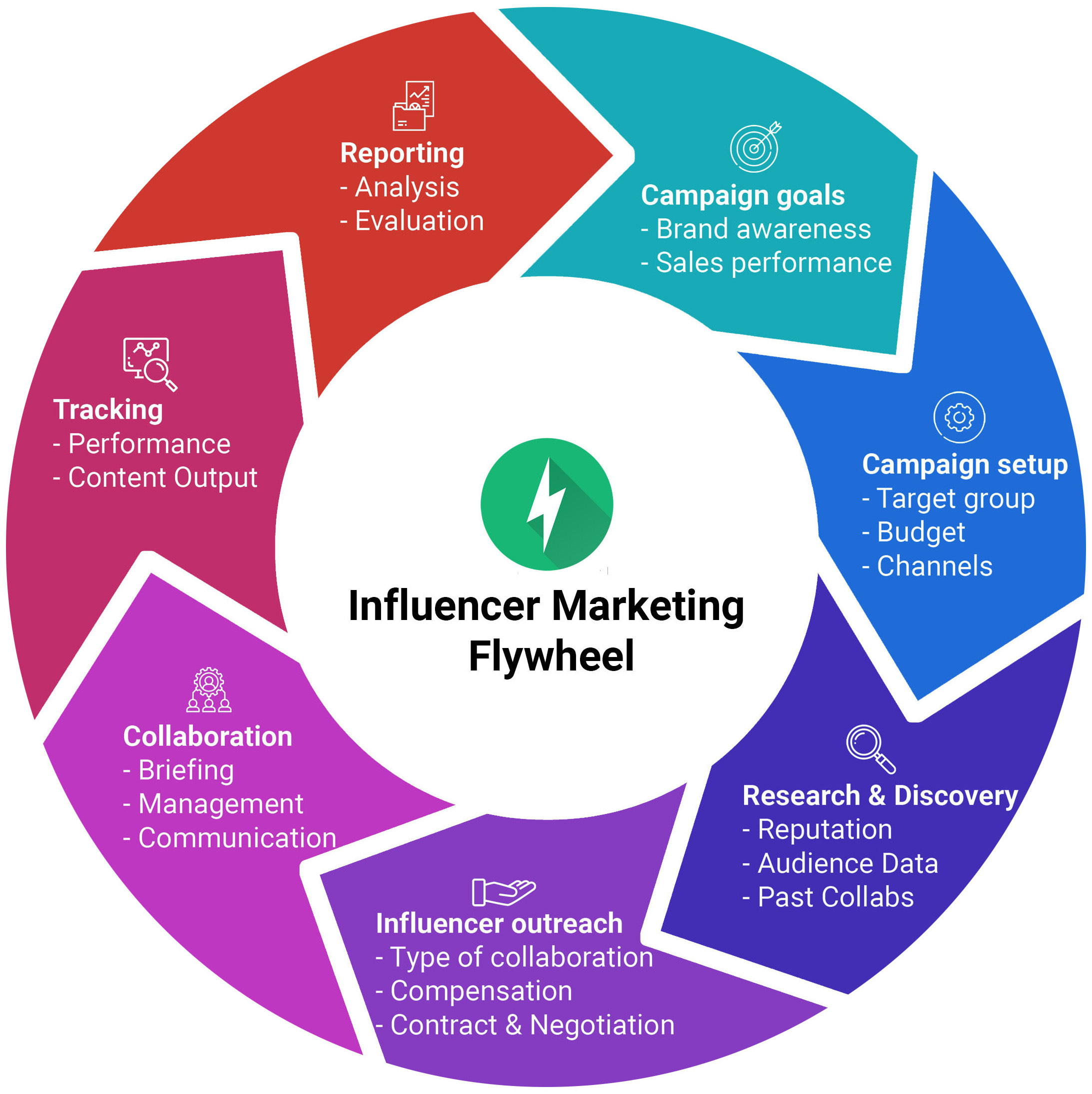The right influencer marketing strategy will help you build brand authority, grow awareness, boost traffic and acquire new customers. However, it can be tricky to find brand-fit creators, figure out the costs, and sort out the legal paperwork—even if you have run campaigns before.
We created this guide to help you create a killer influencer marketing strategy for your brand. Read on to learn how to create a powerful influencer marketing strategy step-by-step, from start to finish.
What is an influencer marketing strategy?
An influencer marketing strategy is a planned approach that brands use to collaborate with influencers who can effectively promote their brand, products, or services.
Influencer marketing strategy involves identifying the right influencers, setting clear campaign objectives, and crafting messages that resonate with the influencer's audience.
The goal is to leverage the trust and authority of influencers to enhance brand visibility, foster engagement, and drive conversions, ensuring each step aligns with the brand’s overall marketing goals.
At Storyclash, we believe that influencer marketing strategy encompasses seven essential elements:
- Campaign goals
- Campaign setup (audience, budget, and platforms)
- Influencer research and discovery
- Influencer outreach
- Collaboration
- Tracking
- Reporting
We call this the “influencer marketing flywheel.”

How to create an Influencer Marketing Strategy
At Storyclash, we work with many top B2C and DTC brands, so we know what sets a winning strategy apart. Follow this step-by-step process to get the best results for your brand.
1. Set your campaign goals
Every strategy starts with setting the right goals or rather – objectives and key results (OKRs) - as many marketers use this system of measuring success. The campaign goals you focus on will depend on your wider business goals:
- Do you need to drive sales and conversions for one of your key product segments?
- Or are you focused on goals like reaching a certain percentage of engagement or reach?
Decide from the start what you are hoping to achieve, as this will help keep you focused throughout the process and also measure results later. Possible campaign goals include:
- Brand awareness
- Sales performance
- Engagement
- Reach
2. Plan your audience, budget, and platforms
Who are you trying to reach when with what budget and where?
The answers to that question are crucial to the success of your campaign.
Audience
You don’t want to spend time and money trying to engage with a certain demographic, only to realize that actually, your product is better suited to a different customer cohort. It is worth spending time analyzing your current customers and digging into your analytics tools to pinpoint the right targeting criteria.
Budget
Your campaign budget will usually depend on your overall marketing budget size and other business priorities. If you’re not sure what your budget should be or would like to double-check, take a look at our comprehensive guide to find out how much influencer marketing costs.
Platforms
Now you know which audience you are trying to reach and how much budget you have to make that happen, the next step is to choose the best social media platforms for your campaign.
Your choice of channel will depend largely on your target audience and their demographics such as age, location and gender. Selecting the right channel or channels is key to the success of your campaign, so choose wisely.
Instagram is a firm favorite for influencer marketing. However, brands can and should leverage other social media platforms as well. TikTok continues to gain in popularity, and many brands now include new platforms like Twitch in their influencer marketing channel mix.
3. Discover authentic influencers who drive value to your brand
Ready to find influencers for your brand? The discovery part of the process is make-or-break for your entire influencer marketing campaign.
The best influencers can tap into engaged audiences that they have carefully nurtured, possibly over several years. Thanks to the high level of trust their followers place in them, they are ideally positioned to introduce your brand to potential new customers. It’s not so easy, though, as brands consistently say finding influencers is their biggest challenge.
When choosing influencers, you will want to consider several aspects, including:
- Brand fit
- Authenticity
- Content quality
- Past brand collaborations
Does their reputation align with your expectations? Do you share the same values? Be sure to check out which other brands they are also working with, as it won’t seem very credible if they are promoting your competitors or brands whose values conflict with yours.
At the discovery stage, top brands are increasingly relying on influencer marketing platforms to identify and investigate the influencers they collaborate with.

4. Reach out and sign a contract
Getting in touch with influencers is an important step. You can use Storyclash to send personalized emails directly through the platform. No need to hunt for email addresses or slide into creators’ DMs.
Not sure what to say? Use our guide to influencer outreach (including free email templates) to get inspired.
Once you've engaged an influencer who fits your campaign, it's vital to get the agreement in writing. This ensures both parties have clear expectations about the scope of work, deliverables, and compensation.
Consider things like: How much are you planning on paying your influencers? Are there any other important conditions, such as exclusivity or rights to use the content on your own channels? It is best to include all of this in an official contract and get it approved by your legal team or legal advisor.
Check out our guide to writing a contract and use our free influencer contract to get a head start.
5. Brief the influencer
Next, you’ll need to provide a clear and detailed brief. This document should outline the campaign goals, key messages, and any content guidelines, providing influencers with the necessary information to deliver content that aligns with your brand’s vision. You can use our briefing template to make this easier.
However, the influencer knows their audience best and understands what kind of content resonates with them. So, it is usually best to give the influencer free rein to get their creative juices flowing. If the brand is overly prescriptive and micro-manages the creative process, the results often turn out bland and inauthentic.
Once you have briefed the influencer, they should come back to you with some creative concepts for approval. Once the content is finalized from their side, and you have approved it, the campaign can finally go live. Yay!
Don’t forget to keep up the communication flow with your influencers in order to ensure good management and the best outcome.
6. Track your campaign
So, you have made it this far and your campaign is live. Congratulations! Now you will want to monitor your campaign to track your return on investment.
After your careful preparation, it is important not to drop the ball at this stage. Conversations on social media can develop quickly. So, you will need to keep a close eye on what people are saying about your brand and how users are reacting to the content.
Make sure to monitor important numbers like:
- Reach
- Engagement
- Sales
- ROI
Don’t forget to track the content output of your influencers as well. Have they uploaded the agreed upon content pieces?
Influencer marketing software like Storyclash makes it easy to track posts & stories in one view, so you can track influencer campaigns and performance.
7. Report, analyze & evaluate
The final part of the process is to measure the results and collect the learnings. Did you achieve your campaign goals? Create reports of the collaborations with all key performance metrics and try to spot any patterns so you will know next time what kind of content and which influencers to focus on.
Influencer Marketing Strategy Checklist
Ready to start planning, managing and evaluating your influencer marketing campaigns like a pro? Look no further than our free Influencer Marketing Strategy Checklist!
Our comprehensive checklist covers all the essential elements of influencer marketing, including:
- Strategy creation
- Influencer discovery
- Managing your partnership network
- Campaign monitoring & reporting
This free checklist will help you organize your influencer campaigns, so you can check off all the important tasks from start to finish.
Ready to learn more?
Keen to learn more about influencer marketing? Check out our top tips on finding the right influencers for your brand or take a look at our list of the top influencer marketing platforms.
You might spot us on top of that list. 😊
